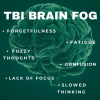Problem solving is the process of finding solutions to complex problems. It allows us to solve everyday problems so we can do our daily activities more efficiently and functionally. There are seven steps involved in problem solving, which is called the problem solving cycle. These steps are:
| Step | Description | Example |
|
Determining the main source of the problem |
|
| 2. Understanding the problem | Consider the reasons behind the problem |
|
| 3. Forming a strategy | Finding a solution |
|
| 4. Organizing information | Find more information about the problem. Consider the questions: What do you know about the problem, and what do you not know about the problem? |
|
| 5. Allocating resources | Determine resources to use to find the solution, i.e., time, money, etc. |
|
| 6. Monitoring progress | Keep track of your progress |
|
| 7. Evaluating the results | Determine if the solution is the best possible solution to your problem |
|
Individuals with impaired problem solving skills may experience:
- Difficulty recognizing the problem
- Difficulty finding solutions to problems
- Inability to come up with new ideas
- A disorderly approach to problem solving
Strategies to improve problem solving skills include:
- Breaking down a task into smaller components
- Lessening demands, i.e., starting out simple, doing one thing at a time
- List pros and cons of each solution
- Trial and error: trying out different solutions until the problem is solved
- Practice divergent thinking: generating different or creative ideas to explore many possible solutions
References:
https://www.psychestudy.com/cognitive/thinking/psychological-steps-problem-solving
https://opentext.wsu.edu/psych105/chapter/7-4-problem-solving/



